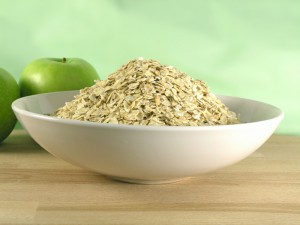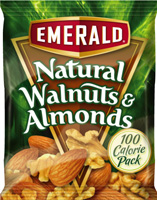Dr. Oz’s Ultimate Health Checklist says knowing your cholesterol is one of your health’s need-to-know-numbers. Optimal cholesterol should be <100 for LDL (bad) and should be >40 for HDL (good). Here are five foods that will help you get those numbers down before your next check-up.
1. Instead of going nuts trying to lower your cholesterol, eat them! Studies show that nuts, specifically walnuts and almonds, help to reduce blood cholesterol. Walnuts and almonds have shown to lower cholesterol and help keep blood vessels healthy and elastic. It’s recommended to consume a cholesterol-lowering diet in which 20% of the calories you eat come from walnuts. (This has shown to lower cholesterol by as much as 12%)! Remember, nuts are high in calories, so portion control is important… eat a handful a day.
 2. Fatty fish pack a punch for heart health. Omega-3 is the miracle worker in fatty fish, which help to lower your cholesterol, blood pressure, and reduce your risk of blood clots. Fatty fish has also shown to help those individuals who have already had heart attacks, by significantly reducing their risk of sudden death. It’s recommended to eat two servings of fatty fish a week (mackerel, lake trout, herring, sardines, albacore tuna, and salmon). If you’re one to pass on fish, try consuming ground/milled flaxseed or canola oil to get the omega-3 you need. There are supplements of fish oil out there, but remember, its always better to eat the whole-food source (you get a mix of nutrients).
2. Fatty fish pack a punch for heart health. Omega-3 is the miracle worker in fatty fish, which help to lower your cholesterol, blood pressure, and reduce your risk of blood clots. Fatty fish has also shown to help those individuals who have already had heart attacks, by significantly reducing their risk of sudden death. It’s recommended to eat two servings of fatty fish a week (mackerel, lake trout, herring, sardines, albacore tuna, and salmon). If you’re one to pass on fish, try consuming ground/milled flaxseed or canola oil to get the omega-3 you need. There are supplements of fish oil out there, but remember, its always better to eat the whole-food source (you get a mix of nutrients).
 3. Oatmeal helps too! Oatmeal contains soluble fiber, which has been shown to reduce “bad” low-density lipoprotein (LDL) cholesterol. This soluble fiber appears to reduce the absorption of cholesterol in your intestines. Only 10 grams of soluble a day can decrease total and LDL cholesterol. One-and-a-half cups of cooked oatmeal gives 6 grams a fiber, to accomplish the 10 needed for the day add fresh fruit to your oatmeal, i.e. a banana to get the other four. You can also find soluble fiber in foods like: kidney beans, apples, pears, psyllium, barley and prunes.
3. Oatmeal helps too! Oatmeal contains soluble fiber, which has been shown to reduce “bad” low-density lipoprotein (LDL) cholesterol. This soluble fiber appears to reduce the absorption of cholesterol in your intestines. Only 10 grams of soluble a day can decrease total and LDL cholesterol. One-and-a-half cups of cooked oatmeal gives 6 grams a fiber, to accomplish the 10 needed for the day add fresh fruit to your oatmeal, i.e. a banana to get the other four. You can also find soluble fiber in foods like: kidney beans, apples, pears, psyllium, barley and prunes.
 4. The beauty behind olive oil is that it contains a potent mix of antioxidants, which lower your “bad” (LDL) cholesterol while leaving your “good” (HDL) cholesterol alone. It’s recommended to use about two tablespoons (23 grams) of olive oil a day to get its heart-healthy benefits. Some research has shown that extra-virgin olive oil is even better for you because the oil is less processed, therefore containing more heart-healthy antioxidants. Note: Avoid “light” olive oils because that usually means they are more processed, lighter in color, and have no fat or calories (remember you are wanting the healthy fat of the olive oil!). Ideas to incorporate it into your diet include: mix with vinegar as a salad dressing, use as a substitute for butter when basting meat, sauté veggies in it, or use it in a marinade.
4. The beauty behind olive oil is that it contains a potent mix of antioxidants, which lower your “bad” (LDL) cholesterol while leaving your “good” (HDL) cholesterol alone. It’s recommended to use about two tablespoons (23 grams) of olive oil a day to get its heart-healthy benefits. Some research has shown that extra-virgin olive oil is even better for you because the oil is less processed, therefore containing more heart-healthy antioxidants. Note: Avoid “light” olive oils because that usually means they are more processed, lighter in color, and have no fat or calories (remember you are wanting the healthy fat of the olive oil!). Ideas to incorporate it into your diet include: mix with vinegar as a salad dressing, use as a substitute for butter when basting meat, sauté veggies in it, or use it in a marinade.
 5. Try foods fortified with sterols or stanols. Sterols or stanols are substances found in plants that help block the absorption of cholesterol. Foods like margarines, orange juice and yogurt drinks have been fortified with these plant sterols, which have been shown to help reduce “bad” LDL cholesterol by more than 10%. The amount of daily plant sterols needed to help lower cholesterol is merely at least two grams a day. This is equal to two 8-ounce servings of plant sterol-fortified OJ a day.
5. Try foods fortified with sterols or stanols. Sterols or stanols are substances found in plants that help block the absorption of cholesterol. Foods like margarines, orange juice and yogurt drinks have been fortified with these plant sterols, which have been shown to help reduce “bad” LDL cholesterol by more than 10%. The amount of daily plant sterols needed to help lower cholesterol is merely at least two grams a day. This is equal to two 8-ounce servings of plant sterol-fortified OJ a day.

